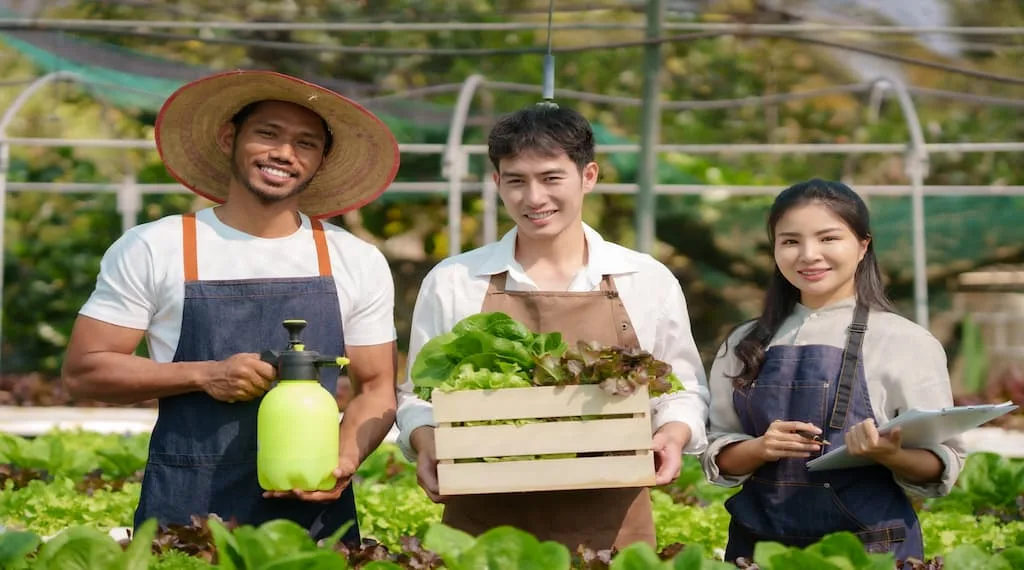Sustainability in foodservice refers to adapting eco-friendly and ethical practices throughout the food supply chain to minimize environmental impact, support local economies, and promote social responsibility. This multifaceted concept and holistic approach involves eco-friendly policies and practices for reducing the environmental impact of culinary operations.
Food and beverage outlets provide individual, social, and economic benefits by feeding hungry stomachs, boosting social connections, and creating employment opportunities. However, they also negatively impact the environment by consuming natural resources, using potentially harmful chemicals, and generating substantial waste. Therefore, exploring the key considerations and economic benefits of sustainability efforts becomes imperative.
Sustainability is not without its challenges. Its financial gains, including cost savings and consumer loyalty, are achievable. Yet, it requires navigating hurdles, such as upfront costs, operational adjustments, supply chain complexities, and effective communication of sustainability efforts. This blog post details the diverse facets of sustainability in food service, an effort to prepare a guide against about the environmental issues caused by commercial kitchens. The 15 important points of this guide that aim to improve our planet’s overall health are:
- Energy Efficiency in Kitchens
- Energy-Smart Kitchen Layout Design
- Water Conservation Techniques
- The Role of Eco-Friendly Packaging
- Supply Chain Transparency
- Embracing Sustainable Sourcing
- Local and Seasonal Menu Planning
- Recycling Initiatives
- Sustainable Building and Design
- Staff Training on Sustainability
- Community Involvement in Sustainability
- Biodiversity Preservation
- Effective Waste Reduction Strategies
- Green Certification Programs
- Reducing Carbon Footprint
1. Energy Efficiency in Kitchens
Energy efficiency is using equipment and practices to minimize energy consumption throughout various kitchen operations, from cooking and refrigeration to lighting and ventilation. Equipment that uses less electricity, gas, and water is the cornerstone of sustainability in foodservice. It lowers utility costs and carbon footprint, ensuring long-term cost savings and showing your commitment to sustainability practices. Also, such equipment often comes furnished with advanced features that enhance overall operational efficiency. Typical implementation strategies include the efforst below:
- Purchasing cooking appliances, refrigeration units, or other equipment with Energy Star or equivalent certifications.
- Investing in energy-efficient technologies like induction cooking, ventless systems, occupancy sensors, and metering faucets.
- Switching to LED lighting, which consumes less energy but provides better illumination.
- Designing the kitchen layout strategically to reduce heat buildup and improve airflow.
- Scheduling routine preventive maintenance to optimize equipment performance.
- Utilizing renewable energy sources like solar panels and wind turbines, if possible.
- Turning off lights and equipment when not in use.
- Checking equipment insulation and upgrading it when necessary.
Sustainability in food service itself needs to be sustainable, too. Consistently monitoring and updating these strategies is crucial to ensure ongoing efficiency. Regular energy audits help evaluate the total energy usage, identify areas of improvement, and set benchmarks. Compare consumption levels of individual appliances through software or smart energy meters. Equipment with wireless connectivity function facilitates this process. Assess the effectiveness of your strategies periodically, considering the seasonal changes, menu variations, and equipment updates.
2. Energy-Smart Kitchen Layout
An energy-smart kitchen layout refers to a strategically designed and refined workspace that prioritizes energy efficiency and environmental impact. Energy-smart kitchen plans significantly contribute to sustainability in food service, reducing the need for excessive heating or cooling and the time and energy required for food preparation and service. Designing such a layout includes thoughtful placement of appliances, workstations, and ventilation systems to minimize energy consumption, reduce heat generation, and optimize workflow. You can achieve this by following the list below:
- Installing all the equipment following the clearance requirements to improve airflow.
- Grouping appliances based on their energy usage.
- Mounting ventilation systems for each group of appliances accordingly.
- Considering natural ventilation solutions where feasible.
- Installing energy-intensive appliances in areas with good ventilation.
- Incorporating natural lighting to reduce reliance on artificial lighting during daylight hours.
- Placing windows and skylights in strategic locations allows natural light to penetrate deep into the kitchen.
- Using light-colored paint and finishes to reflect light and make the space brighter.
Conduct a thorough kitchen workflow analysis before choosing a specific layout. Different kitchen plans affect sustainability in foodservice in different ways.
- The island layout promotes energy efficiency by centralizing cooking and prep areas, which limits unnecessary movements and facilitates workflow.
- The galley layout enhances water conservation by minimizing the distance between sinks and workstations.
- The U-shaped layout supports energy efficiency by grouping equipment, reducing energy loss.
- The open kitchen layout reduces the need for artificial lighting by permitting natural light to flow into the kitchen.
Commercial kitchens are dynamic settings. There is no best strategy that works best in all cases and at all times. Maintaining high levels of sustainability in foodservice requires constant monitoring and updating. Always seek feedback from your employees about the layout’s functionality and comfort to get insights for ongoing adjustments. Also, track workflow metrics and energy consumption to identify areas that need further improvement. When making relevant adaptations, ensure they align with your sustainability goals.
3. Water Conservation Techniques
Water preserving is a collective responsibility. Considering the volumes of water consumed in commercial kitchens for food prepping, cooking, warewashing, and cleaning and its conservation stands at the heart of sustainability in foodservice. Thus, even a drop saved contributes to water conservation. The immediate benefit of adopting water-saving techniques is lower bills. It also helps protect local water resources and ecosystems. Here are 6 implementation strategies listed below:
- Buy water-efficient equipment, including low-flow faucets, pre-rinse spray valves, water-saving dishwashers, and touchless faucets.
- Fix leaks promptly and perform routine maintenance on water-using appliances to prevent water waste.
- Educate kitchen staff about water conservation practices, such as running dishwashers only when fully loaded.
- Implement systems to capture and reuse greywater (lightly used water) and rainwater for non-potable purposes like cleaning.
- Attach aerators to faucets to reduce water flow without compromising water pressure.
- Apply cleaning methods that require less water, such as using microfiber cloths instead of sponges or buckets instead of running water.
Water conservation is an ongoing process. Involving staff and customers in this collective effort is a must. Raise and maintain their awareness through signage or interactive displays. Track water consumption using water meters to spot high water usage areas and adapt your strategies accordingly. Adjustments are particularly necessary after changes in equipment or operational processes. Finally, try to integrate your water preservation practices with other efficiency initiatives for a more holistic approach to sustainability in foodservice.
4. The Role of Eco-Friendly Packaging
Eco-friendly packaging involves using biodegradable or recyclable materials to support sustainability in foodservice. Such packaging solutions decrease plastic waste and the overall ecological footprint, lessening the burden on landfills and reducing the demand for virgin resources. This conscious choice of biodegradable, renewable, or easily recyclable materials helps you both meet your practical needs of packaging and showcase your brand reputation as an environmentally responsible business. 5 easy strategies to implement are listed below:
- Partner with suppliers to source eco-friendly packaging such as biodegradable containers, compostable utensils, and recyclable cups.
- Invest in delivery containers made from greener materials like sugarcane fiber, bamboo, paper, and cardboard.
- Introduce reusable packaging options for dine-in customers, like reusable cups, plates, and cutlery.
- Design menus emphasizing items that require minimal or green packaging.
- Encourage customers to bring their own reusable containers for takeout by offering incentives or discounts.
Eco-friendly packaging options can change as customer preferences and menu items vary. The effectiveness of your efforts for sustainability in foodservice depends on the feedback you collect from staff and customers about their choices. These assessments signal the time for strategic intervals to track progress and results. Analyze the lifecycle of different packaging materials to understand their environmental impact. When updating your material selection, explore industry trends and innovative solutions, like edible coatings or plant-based materials.
5. Supply Chain Transparency
Supply chain transparency means ensuring visibility into the sustainability practices of all suppliers. Openness and truthfulness at every stage of the procurement chain, from growers and suppliers to manufacturers, provide a comprehensive understanding of the social, environmental, and ethical aspects of sourcing, production, and distribution processes. This traceability and accountability throughout the supply chain supports sustainability in foodservice. A transparent supply chain helps identify and mitigate environmental issues like deforestation, labor exploitation, or excessive resource consumption. It also increases businesses’ sustainability credentials and customers’ confidence in them. You can achieve this trust by following the list below:
- Communicating your sustainability expectations and goals to suppliers to set up strong relationships with them.
- Planning regular audits and assessments of suppliers to evaluate their sustainability practices and ensure compliance with ethical, environmental, and labor standards.
- Using software or data management systems to develop robust data collection mechanisms and capture relevant sustainability metrics, including carbon emissions or water usage.
- Seeking independently verified certifications and standards, such as organic, fair trade, or responsible sourcing, to enhance credibility with your customers.
- Implementing advanced traceability solutions, like blockchain, to track and monitor the movement of goods and services along the supply chain.
- Involving customers in the process to get feedback and make further improvements in supply chain responsibility.
- Sourcing ingredients from local or organic suppliers to reduce carbon emissions caused by transportation.
Maintaining supply chain transparency to build customer trust about sustainability in foodservice requires a continuous process. Regular checking and reporting systems are essential for tracking progress and results consistently. Real-time data collection and periodic reviews of documentation standards are other critical components of an effective monitoring framework. Besides regular assessments, major changes in suppliers, sourcing regions, or sustainability goals must trigger an additional review of the supply chain transparency to realign it with your current practices.
6. Embracing Sustainable Sourcing
Embracing sustainable sourcing involves prioritizing locally sourced and organic ingredients. The conscious selection of food items cultivated, harvested, or produced through eco-friendly and ethical practices benefits sustainability in foodservice. Local sourcing removes transportation-related carbon emissions and supports local economies. Relying on local sources builds a strong supply chain that isn’t vulnerable to disruptions. Organic ingredients avoid harmful pesticides and promote soil health. Such environmental consciousness addresses the growing demand for ethically produced, healthier food options.
Sourcing from local producers is also a financially better alternative. However, it requires certain strategies to maintain a strong relationship with regional farmers and businesses. Setting up a systematic approach as below is necessary to develop long-lasting community connections and continue the effectiveness of sustainability in food service.
- Establish direct partnerships to source a significant portion of ingredients locally.
- Design seasonal menus to buy products grown and available in each season.
- Adjust menus periodically to reach ingredients at their freshest.
- Prioritize foods with recognized certifications showing they are organic or local.
- Communicate your locally sourced ingredients to customers through menus, signage, or promotional materials.
- Collaborate with local sustainability in foodservice initiatives and organizations, such as local food cooperatives and community-supported agriculture programs.
- Assess the effectiveness of these strategies regularly and adapt to changes in the availability of local foods.

7. Local and Seasonal Menu Planning
When sourcing from local businesses, you need seasonal menu planning for ‘sustainable’ sustainability in foodservice. Your menu must reflect the changing seasons and incorporate regional ingredients that are readily available during those times. This requires flexibility and creativity in recipe development and menu design. Partner with local organizations to educate kitchen staff about the advantages of planning menus based on seasonal produce availability. Chefs also need training and encouragement to experiment with new ingredients and recipes. Implementing these strategies listed below brings you economic and social benefits:
- Focusing on menu items that align with local produce availability and seasons reduces transportation impacts.
- Minimizing the remote food travels lowers your carbon footprint.
- Adapting to seasonal variations in menu planning makes your menu diverse, exciting, and in tune with the natural rhythm of local agriculture.
- Seasonal ingredients are often harvested at their peak, enabling you to offer customers fresh, flavorful, and nutritionally rich menu choices.
- Highlighting local and seasonal menu items improves local farmers’ economies, promotes a sense of community support, and strengthens regional resilience.
Continuous evaluation is necessary to make these benefits permanent. All the reviews, feedback, and menu planning cycles need to overlap with changing seasons. This naturally keeps your menu offerings relevant and aligned with seasonal variations. While planning the upcoming season, assess the previous season’s success and make adjustments based on ingredient availability. Establishing an information-sharing platform with the stakeholders in your region through conferences, workshops, and webinars helps you update your menu based on the latest trends.
8. Recycling Initiatives
Integration of recycling initiatives significantly fosters sustainability in foodservice. When you organize your waste management according to recycling systems, you separate recyclable materials such as paper, cardboard, metal, glass, and plastic from non-recyclable waste. Recycling helps reduce the amount of waste sent to landfills, conserve natural resources, and minimize environmental pollution. It also contributes to cost savings by lowering waste disposal fees and generating revenue from the sale of recyclable materials.
To start and run recycling initiatives, first, conduct a thorough waste analysis to identify the types and volumes of recyclable materials generated in your establishment. This serves as a baseline for designing effective recycling solutions. Second, use the baseline to build a solid recycling infrastructure with strategically placed recycling bins, clearly labeled containers for different recyclables, and signage promoting proper recycling practices for employees and customers. And to do more about recycling:
- Educate staff on the correct waste separation and recycling producers, conveying to them the importance of recycling initiatives for sustainability in foodservice.
- Work with waste management companies that offer recycling services.
- Communicate your commitment to recycling to customers and encourage their participation.
- Develop and integrate waste reduction programs with your recycling initiatives for a more holistic waste management system.
- Source from suppliers that use recyclable or compostable packaging materials.
An effective recycling initiative requires continuous monitoring to track progress and make necessary updates. You can form internal sustainability committees to oversee whether your recycling efforts are in line with overall sustainability in foodservice goals. Always seek opportunities for improvement following the new recycling technologies and best practices within the industry. Invite your waste management providers to send you regular reports about your recycling volumes. Collecting input from suggestion boxes or team meetings is another form of feedback to evaluate the effectiveness of your recycling initiatives.
9. Sustainable Building and Design
Sustainability in foodservice is not possible without a building that doesn’t lend itself to proper sustainability practices. Sustainable building and design refers to the constructing and maintaining facilities using eco-friendly methods and materials that minimize environmental impact. It involves detailed sketching of the entire building lifecycle, from plumbing fixtures, hoods, and ductwork to electric connections and indoor air quality. The focus must be on water conservation, energy efficiency, and waste management optimization when placing doors, windows, sinks, drainage systems, and appliances.
Such a design makes it easier for staff and guests to support sustainability in foodservice. It fosters a holistic approach to minimizing resource consumption and environmental impact within the facility. A sustainable building design also creates a healthier and more comfortable space for employees and patrons, improving operational efficiency. This is possible through careful planning and execution, from initial design to ongoing operations and equipment selection:
- Define specific sustainability goals, such as energy efficiency targets, water-saving objectives, or waste reduction goals, to guide the design and construction process.
- Collaborate with architects, engineers, and other design professionals specializing in sustainable building practices.
- Plan an efficient waste management framework within the design phase, incorporating recycling stations and composting areas.
- Install water reuse and recycling systems.
- Explore renewable energy options to power your operations and reduce reliance on traditional energy sources.
- Maximize natural lighting and ventilation to reduce the need for artificial lighting and HVAC systems.
- Use eco-friendly and recycled materials in the construction and furnishing of the facility.
- Integrate green roofs or garden spaces, where possible, to enhance energy efficiency, air quality, biodiversity, and aesthetics.
A well-thought-out and executed construction plan that boosts sustainability in foodservice requires constant monitoring and updating when necessary. Track energy and water usage, waste diversion rates, indoor air quality, and other sustainable building systems and practices. Based on the results, implement a maintenance program to ensure these systems continue to operate efficiently over time.

10. Staff Training on Sustainability
The success of all the key considerations of sustainability in foodservice relies on staff training. Providing comprehensive training sessions on waste reduction, sourcing, energy conservation, and other sustainable practices helps foster a culture of environmental responsibility. Through education, staff members realize their roles in establishing a better future and actively participate in your sustainability efforts. Employees who are knowledgeable about sustainable practices contribute to a positive workplace culture. Thus, environmental stewardship becomes an integral part of your daily operations. After developing training programs, you should also follow the 6 action plans below:
- Organize meetings or other discussion sessions for staff members to share ideas and concerns about sustainability in foodservice.
- Incorporate media tools such as videos, presentations, and interactive modules to make training more engaging and accessible.
- Equip staff with written materials, manuals, and resources with ongoing references for best sustainable practices.
- Arrange hands-on training sessions like waste sorting simulations.
- Customize education modules to specific jobs; for instance, train kitchen staff on reducing food waste and chefs on sustainable menu options.
- Reward staff personnel who actively engage in training programs and sustainable practices.
Sustainability practices and technologies are constantly evolving. Keeping staff up-to-date about the latest trends, innovations, and best practices is crucial for ongoing learning. Evaluate the contribution of your educational modules by conducting assessments of staff knowledge about sustainability in foodservice. Quizzes, surveys, or informal evaluations are some testing tools serving this purpose. Also, regularly reassess the effectiveness of your training initiatives and adapt them to emerging needs and industry standards.
11. Community Involvement in Sustainability
Sustainability in foodservice is for the whole community, so it extends beyond your facility’s walls, calling for an interconnectedness between the establishment and the community it serves. Participating in local sustainability efforts and educating the public are essential for community involvement. Raising awareness about sustainable practices inspires behavioral change and creates a positive social and environmental influence. The strong relationships with your customers and other stakeholders enhance your brand reputation as a community-minded business. Here are listed 7 strategies to involve locals in your sustainability initiatives:
- Organize and participate in local sustainability events, such as environmental fairs, farmer’s markets, tree-planting activities, urban gardening programs, or community clean-up campaigns.
- Use these events to advertise your sustainable food options and other eco-friendly practices.
- Collaborate with local organizations for joint projects, workshops, or campaigns to raise awareness about sustainability in foodservice.
- Schedule seminars or cooking classes for the community to educate them about the importance of making sustainable choices.
- Share these through your social media channels to reach a broader audience.
- Provide sponsorships or donations to local sustainability projects, events, or organizations to demonstrate your commitment to community well-being.
- Encourage and facilitate employee involvement in local sustainability programs.
Implementing these strategies is only the first step in community involvement. You need tools and systems to track progress and results. One way to achieve this is to keep attendance and participation logs. You thus know the number of events attended, the participants involved, and the impact of the initiatives on the local community. Social media is also a powerful means of gauging the effectiveness of your efforts by monitoring the reach, likes, and shares. Local news, articles, and blog posts are other media outlets that broadcast a sense of shared responsibility to your community.
12. Biodiversity Preservation
Preserving biodiversity refers to efforts to support and use ingredients from biodiverse sources while avoiding monoculture crops. Maintaining diverse ecosystems and the variety of plant and animal species contribute to our planet’s health. Promoting biodiversity helps safeguard the natural balance of ecosystems, supports the long-term sustainability in foodservice, and protects genetic diversity. It reduces the risks associated with monoculture farming. Also, you expand your culinary diversity when you use diffferent ingredients rather than depending only on certain ones. Use the following strategies to preserve natural habitats, soil health, and genetic diversity:
- Source ingredients from biodiversity-friendly farming practices, including organic farms, agroforestry, permaculture, or regenerative agriculture.
- Build relationships with small-scale farmers and producers who prioritize biodiversity preservation.
- Plan menus that incorporate a diverse range of ingredients, showcasing lesser-known or traditional crops.
- Rotate seasonal menu offerings to promote variety and reduce reliance on a small set of ingredients.
- Develop strategies to limit food waste throughout the supply chain, from production to consumption, to reduce pressure on natural resources.
- Choose sustainable seafood options and support responsible aquaculture practices that protect marine biodiversity.
Strict monitoring is necessary to remain loyal to biodiversity preservation and sustainability. This requires closely tracking the crop rotation cycles of your suppliers and the diversity of the ingredients used in your recipes. Observe the variety of crops, fruits, and vegetables and assess changes over time. Join collaborative research projects into biodiversity-friendly practices like sustainable land management to improve soil health.
13. Effective Waste Reduction Strategies
Effective waste reduction strategies involve implementing practices to minimize the amount of waste generated by commercial kitchens. This includes food waste, packaging waste, and other single-use items. Reducing waste is crucial for sustainability in foodservice as it conserves resources, minimizes environmental pollution, and contributes to a more circular economy. By adopting waste reduction strategies, restaurants lower operating costs and demonstrate a commitment to responsible resource management. Listed of specific examples of waste reduction strategies include actions below:
- Planning menus to minimize food waste by considering ingredient availability, customer demand, and portion sizes.
- Implementing portion control measures to reduce plate waste.
- Maintaining a well-organized inventory system using the first-in, first-out approach to lower the food spoilage risk.
- Setting up composting systems to divert food waste from landfills and use it as a nutrient-rich fertilizer.
- Partnering with local food banks, shelters, and charitable organizations to donate surplus edible food.
- Choosing recyclable, reusable, or biodegradable packaging materials to reduce packaging waste.
There is more to do if you want to ensure the ongoing effectiveness of these strategies and the continuous improvement of sustainability in foodservice. Training staff members and customers on waste reduction practices comes first. To minimize waste, raise employees’ awareness about the significance of proper food handling, storage techniques, and portion control. Encourage guests to request their leftovers to be packed. Emerging technologies and practices in inventory management or waste tracking can also help monitor and analyze your waste data.

14. Green Certification Programs
Green certification programs provide a framework for establishments to demonstrate their commitment to sustainability in foodservice. These programs assess energy efficiency, water conservation, waste management, responsible sourcing, and other sustainable practices. Obtaining green certification enhances your reputation, attracts environmentally-conscious customers, and provides a competitive advantage. Additionally, green certification programs help drive continuous improvement in sustainability practices by setting standards and providing guidance. Most green certification programs charge application and certification fees, but there are government incentives and grants to offset such costs.
Green certification is an ongoing journey rather than a one-time achievement. It requires continuously reviewing and improving your sustainability practices, monitoring performance, and seeking new opportunities. After setting specific, measurable, and achievable objectives for your facility’s sustainability performance, choose a reputable green certification program that aligns with your goals and values about sustainability in foodservice. Most well-known programs are listed below:
- LEED (Leadership in Energy and Environmental Design): LEED, managed by the U.S. Green Building Council, rates buildings by environmental performance and sustainability metrics, such as energy efficiency, water conservation, and materials selection
- ENERGY STAR Certification: ENERGY STAR is a U.S. Environmental Protection Agency program that certifies businesses for their energy-efficient equipment, lighting, and building systems.
- GRA (Green Restaurant Association): GRA is a non-profit organization that measures sustainability in foodservice establishments based on a comprehensive set of criteria, ranging from energy efficiency and waste reduction to sustainable sourcing and community involvement.
- ISO 14001 Certification: ISO 14001 is an international standard that regulates the requirements for an environmental management system.
- USDA Organic: The United States Department of Agriculture (USDA) Organic sets the standards for organic food labels and checks the use of synthetic pesticides, herbicides, and GMOs.
- Fair Trade Certified: Fair Trade certification oversees ethical and sustainable sourcing.
- Non-GMO Project Verified: Non-GMO Project assures consumers that a product follows non-GMO sourcing practices.

15. Reducing Carbon Footprint
Carbon footprint is the total amount of greenhouse gases emitted by an individual, organization, event, or product. It specifies the impact of human activities on global warming and climate change. Restaurants consume energy, transport food, generate waste, and engage in agricultural practices, emitting such gases. Attempts to reduce carbon footprint help mitigate climate change and its adverse environmental and social effects. It also benefits businesses financially through energy-saving practices and improved operational efficiency. The following measures help reduce greenhouse gas emissions and increase your contribution to sustainability in foodservice.
- Use energy-efficient equipment, lighting, and HVAC systems.
- Optimize delivery and transportation routes to minimize fuel consumption and emissions.
- Consider local sourcing, electric, or hybrid vehicles to lower transportation-related emissions.
- Refine your waste reduction, water conservation, recycling, and menu optimization operations.
- Incorporate green building principles into your facility design.
- Participate in carbon offsetting programs.
- Educate your staff about practices promoting carbon footprint reduction.
Every aspect of sustainability in foodservice needs a proactive and adaptive approach for the preferred strategies to remain effective. Regular reviews and updates after significant changes in operations, the introduction of new sustainability initiatives, regulatory amendments, or technological upgrades strengthen the usefulness of your precautions to reduce your carbon footprint. Everything you do must serve to develop a culture of continuous improvement where ongoing reviews and updates are inserted into the organizational mindset.
5 Economic Benefits of Sustainable Foodservice Practices
Sustainable foodservice practices are a pragmatic strategy that yields tangible economic gains, going beyond its environmental benefits. Embracing sustainable practices offers facilities immediate financial benefits in 5 ways:
- Cost savings
- Improved operational efficiency
- Enhanced reputation
- Protection against fluctuations and fines
- Access to market opportunities
Cost Savings
Sustainable practices introduce a range of measures that contribute to substantial cost savings. For instance, energy-efficient appliances and water conservation practices reduce utility bills. Emphasis on minimizing food waste leads to significant savings on disposal fees, while effective inventory management and portion control practices lower ingredient costs. Also, adopting sustainable packaging solutions diminishes expenses related to packaging materials.
Operational Efficiency
Utilizing sustainable building principles and designing your kitchen layout with sustainability in mind promote operational efficiency. Refined workflows and more efficient waste management increase productivity and decrease labor costs. Sustainable businesses incorporate advanced technologies like automated inventory tracking, renewable energy installation, or water recycling systems that enhance operations and reduce manual work.
Customer Loyalty and Retention
There is a growing demand for environmentally conscious dining options. As consumers increasingly prioritize sustainability in foodservice, businesses that offer eco-friendly choices gain a competitive edge. Sustainable practices, including responsible sourcing, community involvement, and biodiversity preservation, resonate with a socially conscious customer base. This attracts new patrons and fosters customer loyalty and retention, making sustainability a powerful driver of increased profitability.
Protection Against Fluctuations & Fines
Sustainable practices help mitigate certain risks and vulnerabilities. For example, diversifying food sourcing to include local and sustainable suppliers reduces dependency on a single source. This minimizes the impact of supply chain disruptions or price fluctuations. Similarly, when you integrate alternative energy technologies, you restrain the risk of future energy price increases. Sustainable practices also align with regulatory requirements, avoiding potential fines, penalties, and other costs associated with non-compliance.
Access to Market Opportunities
Many governments, organizations, and initiatives provide grants, incentives, and financial support to businesses implementing sustainability in foodservice. Applying a sustainability policy also helps build strong, long-lasting bonds with suppliers. Businesses that share suppliers’ sustainability goals can gain economic benefits, such as better pricing, instant discounts, preferential terms, or access to unique product offerings.
Conclusion for Sustainability in Foodservice
Sustainability in foodservice embodies a strategic approach that harmonizes environmental stewardship with economic viability. Embracing this philosophy extends beyond preserving natural resources and reducing carbon footprint—it encompasses a commitment to ethical sourcing, community engagement, and innovative waste management, all while delivering economic advantages.
The integration of energy-efficient practices, water conservation, and responsible packaging translates into cost savings and operational excellence. Moreover, it cultivates customer loyalty and positions businesses to adapt resiliently to market fluctuations and regulatory landscapes. In essence, the pursuit of sustainability within the foodservice sector is not just an environmental imperative but a comprehensive blueprint for enduring success and community prosperity.






